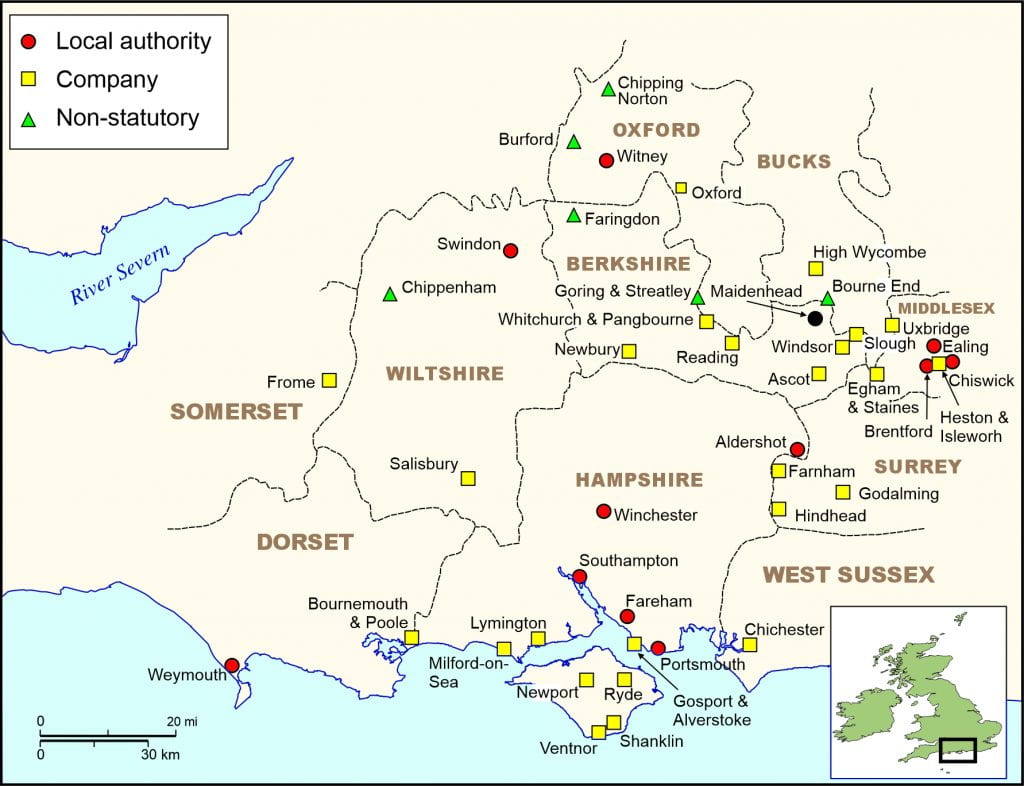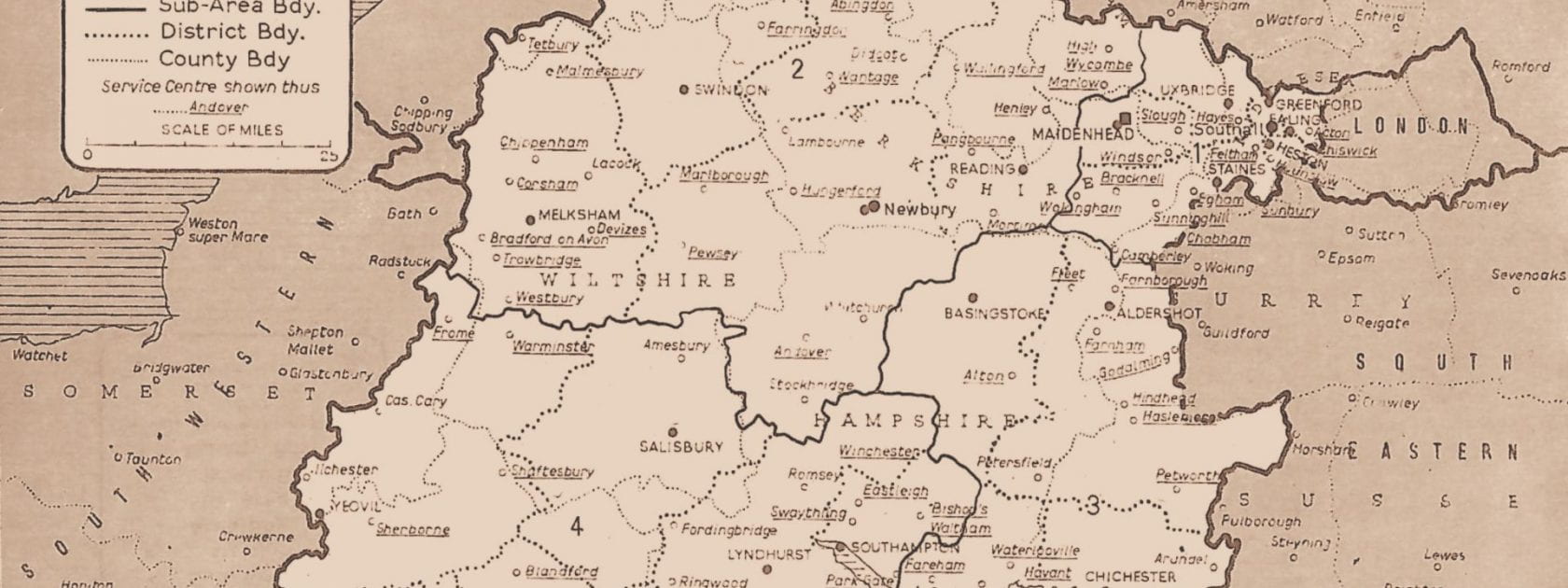Figure 2 and Table 2, derived from a rare map of electricity undertakings in the British Isles, provide a snapshot of the development of public supply areas over the previous three decades.
 Figure 2 Electricity Undertakings in Southern England c. 1912.
Figure 2 Electricity Undertakings in Southern England c. 1912.
The eleven local authorities were clear examples of local initiative in developing electric lighting and power. Portsmouth County Borough (population 233,578 in 1911) was the largest of the local authorities and Witney Urban District (population 3,429) was the smallest. Public electricity supply had begun in Portsmouth and Ealing in 1894 and others followed, sometimes as in the cases of Fareham, Southampton, Winchester and Witney, taking over an earlier private company. Two-thirds of the undertakings in 1912 were companies operating with an Electric Lighting Order which had the approval of the local authority. Bournemouth, Oxford and Reading were the largest urban centres served by companies. In five cases, the operators were non-statutory companies with arrangements for overhead wire service outside the constraints of the Electric Lighting Acts. Non-statutory companies were significant in rural areas from the 1880s until the late 1920s when larger undertakings began expanding beyond town boundaries.[11]
| Undertakings Local authorities | County | Supply Began2 |
| Aldershot | Hants | 1902 |
| Ealing | Middx | 1894 |
| Fareham | Hants | 18901 |
| Heston & Isleworth | Middx | 1904 |
| Maidenhead | Berks | 1902 |
| Portsmouth | Hants | 18942 |
| Southampton | Hants | 1891 |
| Swindon | Wilts | 1903 |
| Weymouth | Dorset | 1904 |
| Winchester | Hants | 18983 |
| Witney | Oxon | 19004 |
| Companies | ||
| Ascot | Berks | 1907 |
| Bourne End N/S | Bucks | 1908 |
| Bournemouth & Poole | Hants/Dorset | 1891 |
| Brentford | Middx | 1911 |
| Burford N/S | Oxon | 1910 |
| Chichester | W Sussex | 1909 |
| Chipping Norton N/S | Oxon | 1912? |
| Chippenham N/S | Wilts | 1909 |
| Chiswick | Middx | 1900 |
| Egham & Staines | Berks/Middx | 1912 |
| Faringdon N/S | Berks | 1912? |
| Farnham | Surrey | 1912 |
| Frome | Somerset | 1904 |
| Godalming | Surrey | 1902 |
| Goring & Streatley N/S | Oxon/Berks | 1900 |
| Gosport & Alverstoke | Hants | 1907 |
| High Wycombe | Bucks | 1898 |
| Hindhead | Surrey | 1900 |
| Lymington | Hants | 1900 |
| Metropolitan ES Co. | London/Mddx | 19055 |
| Milford-On-Sea | Hants | 1903 |
| Newbury | Berks | 1905 |
| Newport/Cowes | IoW | 1903 |
| Oxford | Oxon | 1892 |
| Reading | Berks | 1889 |
| Ryde | IoW | 1903 |
| St Helens | IoW | 1902? |
| Salisbury | Wilts | 1898 |
| Sandown/Shanklin | IoW | 1901 |
| Slough & Datchet | Bucks | 1903 |
| Uxbridge | Middx | 1902 |
| Ventnor | IoW | 1899 |
| Whitchurch & Pangbourne | Berks/Oxon | 1903 |
| Windsor | Berks | 1896 |
N/S non-statutory undertaking (outside 1882/1888 Acts).
1By a company. Taken over by Urban District Council 1896.
2 By a company. Taken over by Corporation 1896.
3 By a company. Taken over by Corporation 1911.
4 By a company. Taken over by Urban District Council c1912.
5 By Acton UDC. Sold to Metropolitan Company in 1911.
Source : “Map showing Electric Lighting, Power and Traction Undertakings in Operation.” Supplement to Garcke’s Manual of Electrical Undertakings. Undated but c 1912. [Copy from National Library of Scotland]
While most companies were local in management, some were subsidiaries of larger national businesses. In the “electricity boom” from the mid-1890s several contracting firms began to develop and operate complete local systems. The largest was Edmundson’s Electricity Corporation Ltd which by 1910 was operating 46 systems from Inverness to Guernsey. Eleven of these were in the Southern Region–at Frome, High Wycombe, Lymington, Isle of Wight (5), Salisbury[12] and Winchester (later sold to the Corporation). Godalming and Newbury were operated by the Urban Electric Supply Co., an Edmundson’s subsidiary.
In the Middlesex suburbs of London, the Metropolitan Electric Supply Co. had begun to expand its service area, first to Acton and then to Southall-Norwood. An Act of 1907 gave the company powers of bulk supply to other undertakings in the area.
Several new undertakings began electricity supply shortly after 1912, including two local authorities—Dorchester (1913) and Basingstoke (1914) and six companies—Abingdon (1913), Blandford Forum (1913), Bognor (1913)[13], Cirencester (c1913)[14], Aldershot District Gas, Water and District Lighting (1914), and Swanage Gas & Electric Co. (1914).
Electrification in the Southern region around 1912 was still incomplete and mostly confined to major towns and some smaller places where local enterprise had developed a system. Significant towns without an electricity service included Portland (population 17,011 in 1911), Eastleigh (15,247), Yeovil (14,487), and Trowbridge (11,815). Only a very small part of the region was covered by Electric Lighting Orders; most of the territory was still unclaimed.
Lighting was the dominant use for electricity until the late 1890s. The most profitable demand was in shops, offices, hotels, theatres (and later cinemas) and public buildings. Residential sales were more limited—by the expense of installation and the high retail prices. With lighting, much of the load on generating equipment was confined to the evening hours, a feature that also contributed to the high prices. Diversification of the load to other uses, especially in the daytime, was essential if electricity was to become a viable alternative to gas. Such diversification began with the electrification of tramways and the substitution of electric motors for small steam engines and manual power.
The 1912 data do not cover private generation which was very important at the time, not only in isolated establishments but also in urban centres where there was already a public supply. Some examples are outlined here to give a sense of the scale and scope of private generation otherwise absent in many accounts of electrification.
Industrial firms were early adopters of electricity, not only for lighting but also for power. At Swindon, the Great Western Railway had a central generating station for the woorkshops, similar in size to the Corporation’s electric light plant. Other major factories in north Wiltshire such as Saxby & Farmer (Chippenham), Spencer & Co. (Melksham), and C & T Harris (Calne) generated their own electricity.[15] The Thornycroft motor works in Basingstoke had begun generating power a decade before the town supply began.[16] When the London & South Western Railway relocated its locomotive works from Nine Elms to Eastleigh in 1909, the new complex included a power station.[17] Southampton Docks was also self-sufficient as was the Naval Dockyard in Portsmouth.[18] In the Isle of Wight, J. Samuel Wight’s shipyard at Cowes included two power houses.[19]
Early major factories in western Middlesex also generated their own electricity. The Gramophone Co. (later EMI) works at Hayes begun in 1907 was developed before any local power supply was available.[20] The Great Western Railway also built a 6,000kW powerhouse at Park Royal in 1906. This station, on the northern boundary of Acton, was needed for the electrification of the Hammersmith & City line and for modernizing the lighting of Paddington station and adjacent yards.[21]
Military establishments began to electrify from about 1900. Aldershot camp had a large power station by 1902 and Tidworth, a new garrison town in Wiltshire had its own power and an “Electric Cinema” by 1914.[22] World War I expanded the number of military camps and depots all requiring diesel-engined generating equipment. New munitions factories at Hayes and Perivale, as well as the vast Royal Navy cordite plant at Holton Heath, west of Poole, also had independent generating facilities.[23] The Government Rolling Mills at Weston Grove, Southampton, had a 6,000 kW power house.[24] The size of these power stations reflected not only the pace and scale of wartime industrial growth but the inadequacy of public supply systems.
[11] It is possible that the companies in Reading and Bournemouth began supplying electricity before Electric Lighting Orders were granted. Avebury, Wiltshire was supplied by a non-statutory company from 1926 to 1948 when taken over by the SEB.
[12] David Coe, Salisbury Electric Light and Supply Company (Salisbury: South Wiltshire Industrial Archaeology Society, Historical Monograph 19, 2008).
[13] William Gage, “Bognor Gas, Light & Coke Co. Ltd, 1865-1939”, Sussex Industrial History—Journal of the Sussex Industrial Archaeology Society, No. 17, 1987, pp.2-13.
[14] D.G. Tucker, How towns got electric light and tramways: A case study of Gloucestershire and neighbouring towns (London: Science Museum, 1978). Chapter 6: Cirencester.
[15] Proceedings of the Institution of Mechanical Engineers, 1908, pp.769-778. Members at the Bristol meeting visited these works. See also The Engineer Vol 94, 1902, p.325 for details of the GWR works in Swindon.
[16] The Engineer, Vol 94, 1902, p.510, noted: “The whole of the power used in driving the works and supplying light is electrical and supplied by two steam dynamos.”
[17] The Engineer, Vol 110, 1910, pp.55-57, 86-88.
[18] By 1928 the RN power station had a capacity of 19,000kW, similar in size to the Portsmouth Corporation’s generating plant. I.Mech.E Proceedings, 1928, p.602
[19] The Engineer, Vol 143, 1929, pp.598-600.
[20] The EMI power station had a capacity of 8,000kW in 1947. I.Mech,E., Proceedings, 1947, p.226.
[21] E.T. McDermot, History of the Great Western Railway, Vol. II, 1863-1920 (London: GWR, 1931), p.441.
[22] Wiltshire Community History – Tidworth. Website www.history-wiltshire.gov.uk.
[23] Wayne D. Cocroft, Dangerous Energy: the archaeology of gunpowder and military explosives manufacture (Swindon: English Heritage, 2000), Chapter 6.
[24] The Engineer, Vol.127, 1919, pp.191-193, 217-219.


